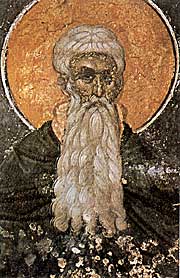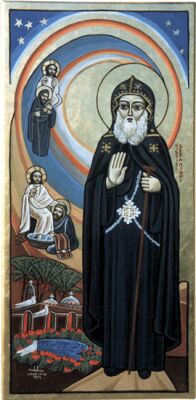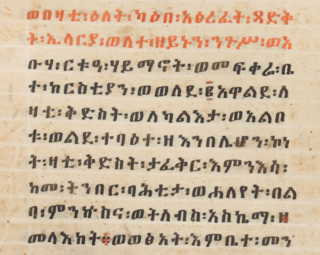Zachariah the Recluse | |
|---|---|
| Born | Egypt |
| Residence | Scetes |
| Died | Egypt |
| Venerated in | Eastern Orthodox Church |
| Feast | March 24 |
Venerable Zachariah the Recluse of Egypt was an Egyptian Christian monk who lived during the 4th century in Scetis, Lower Egypt. He is the patron saint of society's outcasts. He served the homeless and poor, and is remembered as a monastic father.
His father, Carion the Egyptian, left his wife and two children to become a monk in Scetis. Zacharias was later sent to Scetis to become a monk with his father during a famine. [1]
Venerable Zachariah the Recluse is commemorated 24 March in the Eastern Orthodox Church. [2] [3]

Anthony the Great was a Christian monk from Egypt, revered since his death as a saint. He is distinguished from other saints named Anthony, such as Anthony of Padua, by various epithets: Anthony of Egypt, Anthony the Abbot, Anthony of the Desert, Anthony the Anchorite, Anthony the Hermit, and Anthony of Thebes. For his importance among the Desert Fathers and to all later Christian monasticism, he is also known as the Father of All Monks. His feast day is celebrated on 17 January among the Eastern Orthodox and Catholic churches and on Tobi 22 in the Coptic calendar.

Moses the Black, also known as Moses the Strong, Moses the Robber, and Moses the Ethiopian, was an ascetic monk and priest in Egypt in the fourth century AD, and a Desert Father. He is highly venerated in the Eastern Orthodox Church and the Oriental Orthodox Church. According to stories about him, he converted from a life of crime to one of asceticism. He is mentioned in Sozomen's Ecclesiastical History, written about 70 years after Moses's death.

The Desert Fathers were early Christian hermits and ascetics, who lived primarily in the Scetes desert of the Roman province of Egypt, beginning around the third century AD. The Apophthegmata Patrum is a collection of the wisdom of some of the early desert monks and nuns, in print as Sayings of the Desert Fathers. The first Desert Father was Paul of Thebes, and the most well known was Anthony the Great, who moved to the desert in AD 270–271 and became known as both the father and founder of desert monasticism. By the time Anthony had died in AD 356, thousands of monks and nuns had been drawn to living in the desert following Anthony's example, leading his biographer, Athanasius of Alexandria, to write that "the desert had become a city." The Desert Fathers had a major influence on the development of Christianity.

A skete is a monastic community in Eastern Christianity that allows relative isolation for monks, but also allows for communal services and the safety of shared resources and protection. It is one of four types of early monastic orders, along with the eremitic, lavritic and coenobitic, that became popular during the early formation of the Christian Church.
Samuel the Confessor is a Coptic Orthodox saint, venerated in all Oriental Orthodox Churches. He is most famous for his torture at the hands of the Chalcedonian Byzantines, for his witness of the Arab invasion of Egypt, and for having built the monastery that carries his name in Mount Qalamoun. He carries the label "confessor" because he endured torture for his Christian faith, but was not a martyr.

January 9 - Eastern Orthodox liturgical calendar - January 11

John the Dwarf, also called John Colobus,John Kolobos or Abba John the Dwarf, was a Coptic Desert Father of the early Christian church.

Arsenius the Deacon, sometimes known as Arsenius of Scetis and Turah, Arsenius the Roman or Arsenius the Great, was a Roman imperial tutor who became an anchorite in Egypt, one of the most highly regarded of the Desert Fathers, whose teachings were greatly influential on the development of asceticism and the contemplative life.

Wadi El Natrun is a depression in northern Egypt that is located 23 m (75 ft) below sea level and 38 m (125 ft) below the Nile River level. The valley contains several alkaline lakes, natron-rich salt deposits, salt marshes and freshwater marshes.

The Monastery of Saint Macarius The Great also known as Dayr Aba Maqār is a Coptic Orthodox monastery located in Wadi El Natrun, Beheira Governorate, about 92 km (57 mi) north-west of Cairo, and off the highway between Cairo and Alexandria.

The Monastery of Saint Anthony is a Coptic Orthodox monastery standing in an oasis in the Eastern Desert of Egypt, in the northern part of the Red Sea Governorate close to the border with the Suez Governorate.
Zechariah, with many variant forms and spellings such as Zachariah and Zacharias, is a theophoric masculine given name of Hebrew origin, meaning "God/YHWH remembers". It comes from the Hebrew root זכר, meaning to remember, and yah, one of the names of the God of Israel. Though Zechariah is the original transliteration of the name and used in the English translation of the Book of Zechariah, Zachariah, spelled with the letter A instead of the letter E, is more popular, with a common diminutive being Zach. Due to its religious significance, variants of the name exist in numerous languages, and it is also used as a monastic or papal name.

Abba Poemen the Great was a Christian monk and early Desert Father who is the most quoted Abba (Father) in the Apophthegmata Patrum. Abba Poemen was quoted most often for his gift as a spiritual guide, reflected in the name "Poemen" ("Shepherd"), rather than for his asceticism. He is considered a saint in Eastern Christianity. His feast day is August 27 in the Julian calendar.

Bishoy of Scetis, known in the Coptic Orthodox Church of Alexandria as the Star of the Desert and the Beloved of our Good Savior, was a Coptic Desert Father. He is said to have seen Jesus, and been bodily preserved to the present day via incorruptibility at the Monastery of Saint Bishoy in the Nitrian Desert, Egypt. He is venerated by the Oriental Orthodox Churches and the Eastern Orthodox Church, and is known in the latter under the Greek version of his name, Paisios.
The Forty-Nine Martyrs of Scetis were Christian monks of the monasteries of Scetis in Roman Egypt who were massacred by Berbers during a raid in 444. Two laymen were martyred along with them. Their relics lie in the Monastery of Saint Macarius the Great. They are venerated in the Coptic Orthodox Church, but not in the Eastern Orthodox or Roman Catholic churches.

The Legend of Hilaria is a Coptic romance, possibly a Christian version of the pagan Tale of Bentresh. It was written between the 6th and 9th centuries AD. During the Middle Ages, it was translated into Syriac, Arabic and Ethiopic. It tells the tale of Hilaria, daughter of the Roman emperor Zeno, who disguised herself as a man to become a monk and later heals her sister of an ailment. The tale was incorporated into the synaxaries of the Oriental Orthodox churches, and Hilaria came to be celebrated as a saint.
Isaiah the Solitary, also known as Isaiah of Gaza, Isaias the Solitary, Abba Isaiah, or possibly also Isaiah of Scetis, was a Christian ascetic and monastic writer known from the Sayings of the Desert Fathers and various Palestinian Miaphysite sources. He is canonized as a saint by the Coptic Orthodox Church, with his feast day on the 11th day of the month Abib (Epip) in the Coptic calendar.
Bessarion of Egypt, also known as Bessarion of Scetis or Bessarion the Great was an Egyptian Christian monk who lived around the 4th to 5th century in Egypt, wandering in the Nitrian Desert.
Carion the Egyptian was an Egyptian Christian monk who lived during the 4th century in Scetis, Lower Egypt. He was one of the Desert Fathers.
Koiak 29 – Coptic calendar – Tobi 1